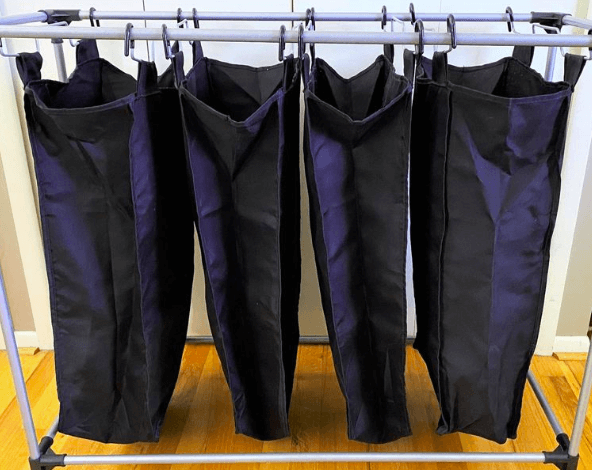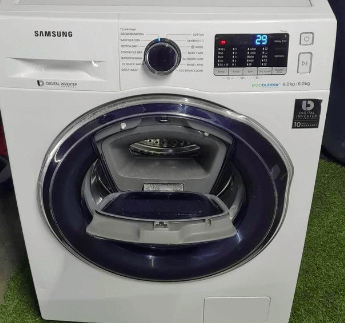Washing colored clothes presents many variables to consider; chief among them is that they tend to fade over time. Preserving the color for as long as possible should be the primary concern when washing colored clothes.
Here are some tips to note and add to your washing routine.
1. Sort the Clothes

Whenever colored clothes come in contact with water or any solvent, the dye seeps out in a phenomenon known as color bleeding. The degree of color bleeding depends on the fabric manufacturing process.
These days dyeing technology makes clothes color-fast, which means they don’t bleed color, but you still have to be careful when washing colored clothes to avoid color bleeding from one cloth and staining another.
The advice is to separate our white clothes from colored ones, but you should also separate different colors from each other.
For instance, you should separate dark-colored clothes from light-colored clothes. You can even separate clothes according to how they fall on the color wheel.
Put red, orange, and yellow clothes in the same pile and blue, green, and purple ones in a separate pile.
Wash jeans separately from other clothing types but separate them into blues and blacks.
Also, separate clothes by fabric type because individual fabric types require different wash settings.
2. Choose the Correct Wash Settings
The wash cycles on washers have different settings based on the fabric type you are washing.
Read the care label attached to the clothes to know the correct wash setting to employ. The care label will give instructions such as,
- Set a “normal” wash cycle or “delicate” wash cycle.
- Whether the cloth is machine washable, hand wash only, or dry clean only
- What kind of drying heat to employ.
The wash setting is the spin speed the washer will use for each load. Using the wrong wash settings will cause strain on the clothes, causing shrinking and wrinkles, and colored clothes will fade.
Another setting that is crucial when washing clothes is the water temperature. The hot water loosens clothes fabrics and releases the dye, which exacerbates color bleeding.
The water temperature might not affect the color-fast clothes, especially ones with durable fabrics, but it is better to use cold water.
3. Use the Proper Detergent

The first thing to consider is what form you want the detergent to be, liquid, powder, or pod. Liquid detergents dissolve well and can double as a stain remover, but they contain many additives. Powdered detergents are cheaper but don’t dissolve well; pods enable accurate measurement, but user experience and functionality can be challenging.
After settling on the detergent form, eliminate based on additives you want to include or exclude in your washing. When washing colored clothes, do not include bleach, so you want to avoid those types of detergents.
The correct amount of detergent can be the difference between your clothes maintaining their vibrant color and fading away. Excessive use of detergents leaves residue on the clothes that can cause damage or fade.
4. Treat Stains
Stains are an inconvenience on clothes, especially colored ones that require less frequent washing to preserve the color.
You can spot-treat stains with a stain remover without running it through a gruesome wash cycle.
It’s best to get stains the instant they occur before they set into the fabric when it will be tougher to remove.
Quickly dab the stained area with a paper towel and rinse it with cold water, not hot water, as it will set the stain further.
Pour the stain remover on the stained area and leave the treatment to soak for a few minutes. Scrub the stains and rinse the clothes.
Pre-treating the stains will allow you to have shorter wash times, reducing the stress on the clothes.
5. Load the Washer

Loading the washer is vital because it determines how your clothes will look after the wash.
After sorting and separating the clothes, divide them into different loads. It is better to have multiple wash cycles than for you to overload the washer.
When you pack a bunch of clothes into the washer, they will clump together and not have enough room to move.
These tightly-packed clothes will cause the following reactions:
- The clothes will not wash well.
- The clothes will bleed color.
- The clothes will rub against each other, causing wrinkles and tears.
- The detergent residue will remain in the clothes.
- The washer will encounter mechanical damage.
These reactions will cause the colored clothes to be damaged and lose their color.
Put in reduced loads at a time to avoid these problems.
Another tip to note when loading the washer is to turn the clothes inside out. Doing this will prevent friction and abrasion from affecting the front side of the clothes.
This step is usually for dark-colored clothes like black, gray, navy blue, army green, etc., which can lose their sharp color.
6. Take Extra Care of Delicates
Most of the tips in this list are suitable for durable fabrics like cotton. Delicate fabrics require special care and attention to prevent the washer from damaging them.
First, delicates have their wash cycle with slow spin speeds and cold water to preserve the integrity of the clothes. However, you can take extra care to prevent fabric and structural damage.
Place delicates like underwear and bras inside mesh bags before putting them in the washer. These mesh bags will protect the fabric and the structure of the items.
Sometimes, it is better to avoid a washer when caring for delicate fabrics. Hand wash the clothes in a bowl or bathtub to have control of the agitation and friction intensity. You will also see if the clothes are getting tears during the wash.
7. Dry the Clothes

Remove the clothes from the washer the instant the wash cycle ends. When you leave wet clothes clumped together in the washing machine, the color starts to bleed and stain other clothes. Color bleeding is the number one cause of fading, so you should avoid that.
Always read the care label to know how to dry the clothes, whether in a machine or air-drying.
Air-Drying
The intense tumbling in the dryer is too much for dark-colored clothes as it can fade the colors. Some people prefer air-drying as a result.
When air-drying, hang the clothes on a drying rack in a well-ventilated room with a fan and a humidifier to reduce drying time. The color will continue bleeding if the clothes stay wet for too long.
The best way to air-dry colored clothes is to hang them on a clothesline under direct sunlight. The heat of the sun will dry the clothes faster and brighten them. However, the sun has natural bleaching properties, so you should avoid drying dark-colored clothes under direct sunlight, or they will fade.
Tumble Drying
When you tumble dry your colored clothes, do so with low heat or the air fluff setting to reduce the intensity on the clothes. Dryers have various heat settings for different fabric needs. The care label should be your guide for the heat setting to choose.
Place dryer sheets or wool dryer balls with the clothes to reduce static and drying time. Clothes spending less time in the dryer preserve their color.
Bonus Tip: Repair Seams
Before washing the clothes in the washer, check for tears and loose seams, and repair them. Placing the clothes in the washer without repairing them will increase the damage.
